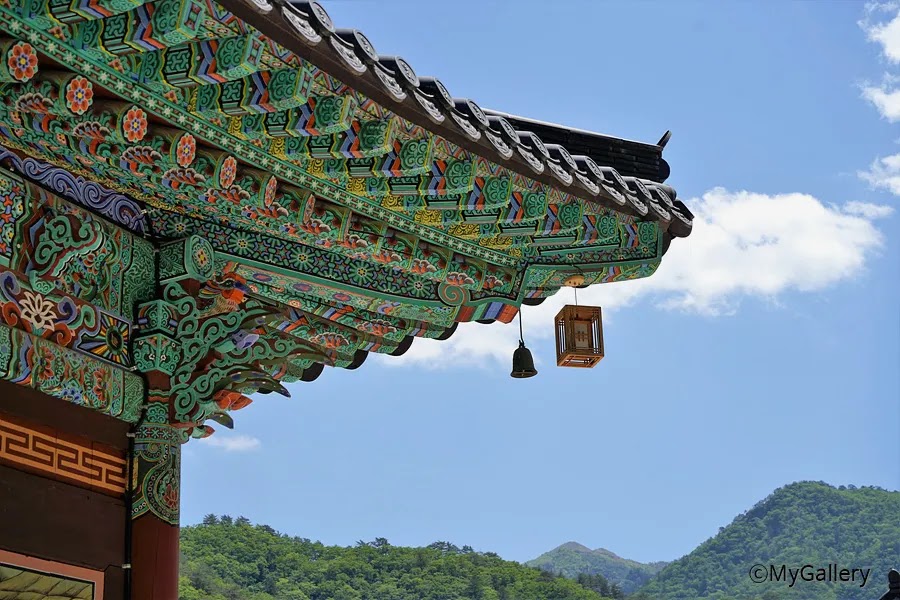Baekdamsa Temple is the largest temple in the very deep valley of Seoraksan Mountain. The history of the temple is very old, and there are many visitors here. However, it is very difficult to visit here. You can't go directly by car. In order to visit Baekdamsa Temple, you need to buy a bus ticket at the bus ticket office to Baekdamsa Temple and take a small village bus up the narrow valley for about 15 minutes.
The road to Baekdamsa Temple is a one-lane unpaved road that winds around. Before going to this temple, it is a steep cliff road, so you can feel a lot of tension. Of course, the bus driver's driving skills are good, so you don't have to worry about actually falling.
About Baekdamsa
Baekdamsa Temple was originally founded in the 7th century under the name of Hangyesa Temple. However, the names were later changed to Unheungsa Temple, Simwonsa Temple, Seonjeonsa Temple, and Yeongchwisa Temple. It was renamed Baekdamsa Temple in 1783 during the year of King Jeongjo (1783) of the Joseon Dynasty.
Baekdamsa Temple is also famous for it's repeated destruction and reconstruction through numerous fires so far. The origin of the name Baekdamsa Temple is also derived from the fact that there are 100 water walls between the temples at Daecheongbong Peak in Seoraksan Mountain.
The name was given to prevent fires by borrowing the energy of water. However, even after the name was changed to Baekdamsa Temple, a fire broke out. The current Baekdamsa Temple was rebuilt in 1957 after being burned to ashes during the Korean War.
The way to Baekdamsa Temple
Susimgyo Bridge is a stone bridge that built across the Baekdam Valley to Baekdamsa Temple.
Why Baekdamsa Temple became a famous temple in Korea
There are three main reasons why Baekdamsa Temple is famous in Korea.
The first is that it was the place where Manhae Han Yongun, an independence activist and monk during Japanese colonial era, lived and wrote such things as "The Silence of Love" He is a very famous monk and literary man in Korea. Han Yong-woon's famous poem, The Silence of Love, will be introduced separately at the bottom.
Second, it is here that former President Chun Doo-hwan hid away from people's eyes after being inherited as if he were kicked out of the presidency as a result of the democratic uprising in June 1987.
Third, Baekdamsa Temple is located in a very secluded place, so people come to it. In particular, all the people who visited Seoraksan Mountain want to visit Baekdamsa Temple.
Baekdamsa Temple stay
It also offers temple stay programs where visitors can experience Buddhist culture for foreigners.
The way to Baekdamsa Temple
How far is it from Seoul to Baekdamsa?
The distance between Seoul and Baekdamsa is 139 km.
How do I get to Baekdamsa Temple
• Address 746, Baekdam-ro, Buk-myeon, Inje-gun, Gangwon-do 252-821, Korea
• Departure from Seoul
From Dong Seoul Bus Terminal, take an intercity bus to Baekdamsa (백담사).
Bus schedule: 06:35-21:10, at 30 min-1 hr intervals
From Baekdamsa Intercity Bus Terminal, go 100m till Baekdam Intersection (백담교차로)
At the intersection, turn right onto Baekdam-ro (백담로)
Go 1km to arrive at the Baekdamsa Temple Ticket Office.
Baekdamsa Temple Information
• Homepage www.baekdamsa.org
• Email baekdam4@templestay.com
• Telephone 033) 462-5565\5035
The Silence of Love
By Manhae Han YongUn
My love has gone. Ah, my sweet love is gone.
Breaking the blue light of the mountain, through the narrow lane leading to the maple woods, he’s gone.
Our oath which was bright like the golden flowers turned to black chaff and was blown away by the breeze of sigh.
The keen memory of our first kiss stepped backward and disappeared after it changed the direction of my destiny.
I was deafened by his sweet voice and blinded by his flowery face.
Love is also a human affair, therefore I was worried and cautious against parting when I first met him.
But his departure came so suddenly that my faint heart burst in new grief.
Yet if I shed tears, it will mean the real end of our love, I`d rather pour the power of unbearable grief into the crown of the head in new hope.
As we care about parting when we meet first, so we believe in meeting again when we part.
Alas, My love has gone, but I did't send her away.
The melody of love song which cannot bear its own tune is floating around the silence of the love.
Manhae (pen name) Venerable Han Yongun (1879-1944) Memorial in Baekdamsa
He was born in 1879 in Hongseong, South Chungcheong Province. In 1905, he was ordained by Monk Yeongok here at Baekdamsa Temple. His legal name was Gonghwan, his martial law was Yongwoon, and his pen name was Manhae. In the March 1st Movement of 1919, he represented the 33 Activities Movement and declared the independence of the country. Because of that, he was imprisoned for three years, and others returned to pro-Japanese. After that, he kept his faith and continued to strive for freedom of his country and innovation in Buddhism until the end. Manhae's most famous work is "The Silence of Love," a collection of poems, along with many other works. More than 800 articles are displayed at the Manhae Memorial Hall in hopes of reviving his spirit.
By Mygallery.com













.jpg)


Social Plugin